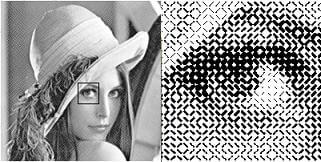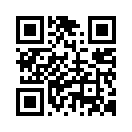Matrix codes are like bar codes on steroids. To the naked eye, they look deceptively like a series of dots in a rectangular pattern. They’re being used by Japanese companies to identify buildings, by zany German engineers to greet the world via Google Earth using crop circles, and in augmented reality, to tell the viewing device how to create the imaginary object in the user’s field of vision.
But one of the most exciting applications is individual users’ ability to encode URLs or other information of their own choosing into articles of clothing. QR Stuff, for example, allows the user to generate a code indicating a personal URL (say, a blog, or a Facebook profile), and print it on a t-shirt. When a code-savvy stranger recognizes that you’re wearing a matrix code, they can take a picture of it with their phone and translate it into the related URL with a free app like NeoReader. You could have a whole wardrobe of augmented clothing; some days you wear a shirt that indicates your Facebook profile, and some days it’s your Twitter page. The services are (mostly) free, and the code is (mostly) in the public domain. The only thing you have to pay for is the shirt.
Wearing a personal matrix code is like saying: Want to know more about me? Start here. It may lead to a song, or the website of your favorite charity, or an augmented reality image of your World of Warcraft avatar, or a 500-point online quiz that the user has to pass before getting your email address. And that’s not just a novelty. It represents a sea change in the way that individuals get in touch with each other after meeting in the real world. It also represents a sea change in how businesses will reach out to consumers. Google has started sending out QR-code enabled window decals to businesses that it deems “Favorite Places,” and that’s just the tip of the iceberg.
Consider phone numbers. You meet someone you like: did you “get the digits?” You know, the sequence of arbitrary numbers that are the gateway to interacting with that person through a massive system that was, for many years, the definitive way to communicate across distances? When Alexander Graham Bell invented the telephone, it wasn’t part of a scheme to cause people to identify themselves to likeable strangers with a series of numbers. It just happened. Similarly, real-life relationships are increasingly defined by online relationships in pre-defined categories. You and I are either friends on Facebook, or we’re not. Facebook has no setting for “acquaintance.”
Companies like W-41 are making their own matrix-enabled shirts. Interestingly, W-41 also offers guidance as to how their products will smooth customers’ social transactions: their ads depict attractive young people wearing shirts with codes on the back while facing the other direction, simultaneously offering their code to the world, but being unaware of its use on a case-by-case basis. Surely the animated demo is meant to put users at ease, but it made me wince. Is it necessary to wear our codes on our backs, in order to save our interlocutors the awkwardness of raising their phones to capture the codes while we’re watching? The situation begs for tech that allows the data to be captured as unobtrusively as it’s displayed (doesn’t it?).
Speaking of displaying data unobtrusively. Data matrix codes are cool, but they all have a recognizable look about them that is destined to be associated with this decade as much as denim jackets are forever tied to the 1980s. The technology sure to replace them is already here; it’s just proprietary, expensive and impossible to implement by hand: data glyphs. Data glyphs, invented by Rob Tow, who reminisces about them here, are like matrix codes so intricate that they can be seamlessly hidden in unrelated images. The tiny blots of ink that make up a painting can either slant to the right or the left, and the difference can be effected at a scale so minute that it’s imperceptible to the human eye. What we’re talking about is no less than the ability to discreetly encode information about anything inside of an image of anything else. The image on your glyphed-out t-shirt might look like a picture of the Mona Lisa to the naked eye, but when viewed through a mobile device, it could be revealed as a ten thousand word personal manifesto, or a video game, or a movie.
Like telephone poles and printing presses, matrix codes will be remembered in the future as the hallmarks of a fundamentally new and different way of seeing the world. Even if, in the greater scheme of things, they themselves will only be visible for a short time.
[image credits: QR Stuff, public domain, Google, Playboy (as per fair use)]
[sources: QR Stuff, X-41, Rob Tow (via TauZero)]





